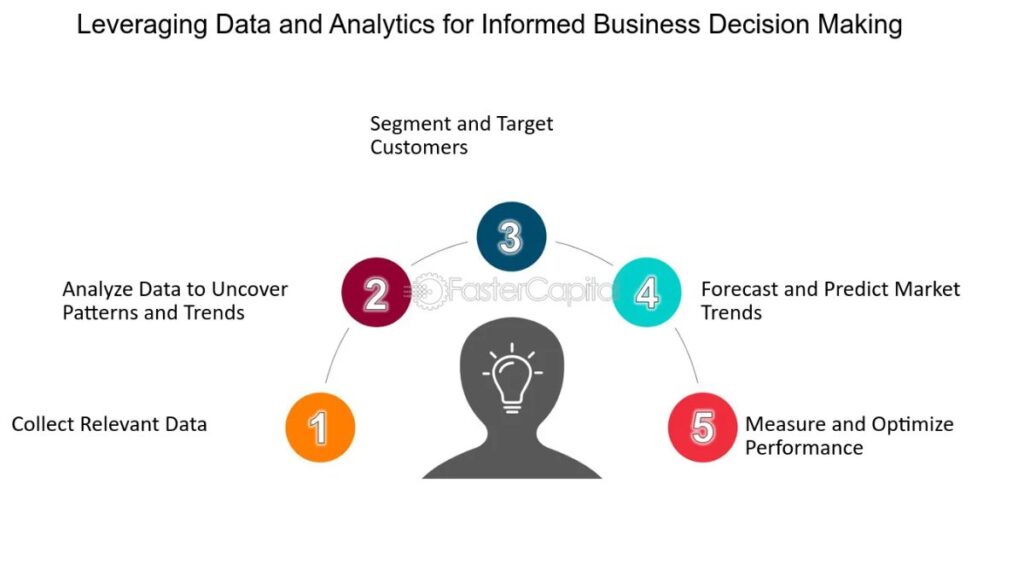In today’s fast-paced business environment, organizations are increasingly relying on data analytics to enhance decision-making processes. Business decision-making is no longer solely based on intuition or past experiences; it is now driven by data. As businesses accumulate vast amounts of information, it becomes crucial to understand how to leverage data analytics effectively to gain insights, drive informed decisions, and achieve sustainable growth. This article will explore the concept of data analytics and how businesses can use it to improve their decision-making processes.
Understanding the Role of Data Analytics in Business Decision-Making
Data analytics refers to the systematic computational analysis of data to uncover patterns, trends, and insights that can guide business decisions. This process involves collecting, cleaning, and analyzing data to gain actionable insights that can influence strategic directions, optimize operations, and enhance customer experiences. In the context of business decision-making, data analytics empowers organizations to make data-driven decisions, moving away from subjective judgment and allowing for a more objective approach.
By integrating data analytics into decision-making processes, businesses can improve efficiency, minimize risks, and identify new opportunities. Data analytics also allows companies to forecast future trends, make predictive models, and analyze customer behavior, all of which contribute to more effective decision-making across various departments, including marketing, finance, operations, and human resources.
Types of Data Analytics Used in Business Decision-Making
Businesses use different types of data analytics to address specific problems or improve performance in particular areas. The primary types of data analytics used in business decision-making are descriptive, diagnostic, predictive, and prescriptive analytics.
1. Descriptive Analytics
Descriptive analytics is the most basic type of data analysis. It involves examining historical data to understand what has happened in the past. By reviewing past business performance and trends, businesses can identify patterns and anomalies that can inform future decisions. Descriptive analytics helps answer questions like: “What were our sales figures last quarter?” or “How did our customers respond to our marketing campaign?”
This form of analytics is valuable for creating reports, dashboards, and summaries that provide a clear picture of historical performance. It helps businesses track key performance indicators (KPIs) and provides insights into areas that may need improvement.
2. Diagnostic Analytics
While descriptive analytics answers “what happened,” diagnostic analytics takes it a step further by exploring “why it happened.” This type of analytics digs deeper into the data to uncover the causes behind certain outcomes. For instance, if sales dropped in a specific region, diagnostic analytics will help businesses understand the factors driving the decline, such as market conditions, customer preferences, or competitor activities.
Diagnostic analytics often involves the use of advanced tools like regression analysis, correlation analysis, and data mining techniques. It helps decision-makers identify relationships and dependencies between variables, which can aid in more targeted and effective strategies.
3. Predictive Analytics
Predictive analytics leverages historical data to forecast future trends and outcomes. By using statistical algorithms, machine learning models, and forecasting techniques, predictive analytics can provide businesses with insights into potential future scenarios. For example, predictive analytics can help businesses predict future sales, identify upcoming market trends, or anticipate customer behavior.
In business decision-making, predictive analytics is valuable for risk management, inventory planning, resource allocation, and customer relationship management. It enables organizations to anticipate challenges and opportunities before they arise, allowing for proactive decision-making.
4. Prescriptive Analytics
Prescriptive analytics goes beyond predicting future trends; it recommends actions businesses should take to achieve desired outcomes. By utilizing optimization algorithms, simulation models, and decision-analysis tools, prescriptive analytics can provide specific guidance on the best course of action.
This type of analytics is especially useful in decision-making scenarios that involve complex variables, such as supply chain optimization, workforce management, and pricing strategies. Prescriptive analytics not only predicts future outcomes but also suggests the most effective strategies for improving performance and achieving business goals.
How to Leverage Data Analytics for Business Decision-Making
Now that we understand the various types of data analytics, let’s explore how businesses can leverage these tools to enhance decision-making processes and drive better outcomes.
1. Collect and Clean Relevant Data
The first step in leveraging data analytics for decision-making is ensuring that the data collected is relevant, accurate, and clean. Businesses need to gather data from various sources, such as customer transactions, social media interactions, website traffic, and internal operations. However, raw data is often unstructured, incomplete, or inconsistent, which can impact the quality of insights.
Data cleaning is a crucial process that involves removing duplicates, correcting errors, and filling in missing values. By ensuring the quality of the data, businesses can derive more accurate and reliable insights, leading to better decision-making. Companies may choose to invest in data management tools or platforms that streamline the collection and cleaning of data to enhance efficiency.
2. Invest in Advanced Analytics Tools and Technologies
To make the most of data analytics, businesses need to invest in advanced analytics tools and technologies that can handle large volumes of data and perform complex analyses. These tools can range from basic business intelligence software to sophisticated machine learning platforms. Cloud-based platforms, such as Google Analytics, Tableau, Power BI, and SAS, offer businesses access to powerful data analytics capabilities without the need for extensive in-house infrastructure.
By implementing the right analytics tools, businesses can automate data collection, generate real-time reports, and perform advanced analyses that would be difficult to execute manually. Furthermore, these tools allow decision-makers to visualize data through interactive dashboards, making it easier to interpret insights and take action based on the data.
3. Foster a Data-Driven Culture
For businesses to truly leverage data analytics, they must cultivate a data-driven culture. This means encouraging employees at all levels to use data to inform their decisions and integrate analytics into their daily operations. Leaders should set the example by promoting data-driven decision-making in their strategic planning processes and fostering an environment where data insights are valued.
Providing employees with the necessary training and resources to understand and apply data analytics is essential. By empowering staff to use data in decision-making, businesses can unlock the full potential of their analytics investments and make better, more informed decisions across the organization.
4. Align Data Analytics with Business Goals
Data analytics should never be used in isolation. For data-driven decision-making to be effective, it must align with the organization’s overall business goals. Whether it’s increasing revenue, improving customer satisfaction, or enhancing operational efficiency, data analytics should support the objectives of the business.
Before diving into data analysis, businesses must clearly define their goals and identify the key metrics that will drive success. This ensures that the data being collected and analyzed is relevant and directly tied to the company’s mission. By aligning data analytics with business goals, organizations can ensure that the insights generated will lead to actionable outcomes that contribute to growth and success.
5. Use Data to Drive Personalization and Customer Insights
One of the most significant advantages of leveraging data analytics in business decision-making is the ability to better understand customers. Through customer behavior analysis, businesses can segment their audience, identify preferences, and predict future needs. This level of insight allows for more personalized marketing strategies, product offerings, and customer engagement initiatives.
By understanding what customers want and how they behave, businesses can create tailored experiences that improve customer satisfaction and loyalty. Personalized recommendations, targeted promotions, and customized communication can all be driven by data analytics, leading to increased customer retention and revenue growth.
6. Continuously Monitor and Optimize Decisions
The business environment is constantly evolving, and so are customer needs, market conditions, and industry trends. As such, decision-making should not be a one-time event but a continuous process. Data analytics allows businesses to monitor their performance in real-time, track changes in key metrics, and adjust their strategies accordingly.
By continuously analyzing data and monitoring business performance, organizations can stay ahead of potential challenges, capitalize on emerging opportunities, and optimize their decision-making processes. Regularly revisiting data insights ensures that businesses remain adaptable and responsive to changes in the marketplace.
Conclusion
In today’s data-driven world, businesses cannot afford to rely solely on intuition or past experiences when making decisions. Leveraging data analytics is essential for making informed, objective, and strategic decisions that lead to long-term success. By investing in the right tools, fostering a data-driven culture, and aligning analytics with business goals, organizations can unlock the power of data to drive smarter decisions, optimize operations, and gain a competitive edge. As data continues to grow in importance, those businesses that embrace data analytics as a core component of their decision-making processes will be better positioned for success in the future.






